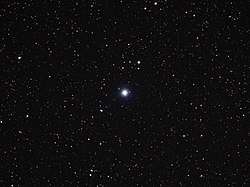Alpha Lacertae
 α Lacertae in optical light | |
| Observation data Epoch J2000.0 Equinox J2000.0 (ICRS) | |
|---|---|
| Constellation | Lacerta |
| Right ascension | 22h 31m 17.5010s[1] |
| Declination | +50° 16′ 56.969″[1] |
| Apparent magnitude (V) | 3.777[1] |
| Characteristics | |
| Spectral type | A1 V[1] |
| U−B color index | 0.00[2] |
| B−V color index | +0.01[2] |
| R−I color index | −0.03[2] |
| Astrometry | |
| Radial velocity (Rv) | −4.0 ± 2[1] km/s |
| Proper motion (μ) | RA: 137.22[1] mas/yr Dec.: 17.15[1] mas/yr |
| Parallax (π) | 31.86 ± 0.54[1] mas |
| Distance | 102 ± 2 ly (31.4 ± 0.5 pc) |
| Absolute magnitude (MV) | 1.27[3] |
| Details | |
| Mass | 2.194[4] M☉ |
| Radius | 2.1432±0.0737[4] R☉ |
| Luminosity | 27.6750±0.2138[4] L☉ |
| Luminosity (bolometric) | 27[5] L☉ |
| Temperature | 9050±157[4] K |
| Rotational velocity (v sin i) | 146[2] km/s |
| Age | 400[4] Myr |
| Other designations | |
| Database references | |
| SIMBAD | data |
Alpha Lacertae (Alpha Lac, α Lacertae, α Lac) is an A-type main sequence star in the constellation of Lacerta.[1] It is the brightest star in Lacerta and has an apparent visual magnitude of approximately 3.777.[1][5]
The star has a visual companion, CCDM J22313+5017B, of spectral type A and apparent visual magnitude 11.8, approximately 36 arcseconds away.[6] The companion is optical, a chance line-of-sight coincidence.[2]
Naming
In Chinese, 螣蛇 (Téng Shé), meaning Flying Serpent, refers to an asterism consisting of α Lacertae, 4 Lacertae, π2 Cygni, π1 Cygni, HD 206267, ε Cephei, β Lacertae, σ Cassiopeiae, ρ Cassiopeiae, τ Cassiopeiae, AR Cassiopeiae, 9 Lacertae, 3 Andromedae, 7 Andromedae, 8 Andromedae, λ Andromedae, κ Andromedae, ι Andromedae, and ψ Andromedae. Consequently, α Lacertae itself is known as 螣蛇一 (Téng Shé yī, English: the First Star of Flying Serpent)[7]
References
- 1 2 3 4 5 6 7 8 9 10 11 "* alf Lac". SIMBAD. Centre de données astronomiques de Strasbourg. Retrieved September 3, 2008.
- 1 2 3 4 5 HR 8585, database entry, The Bright Star Catalogue, 5th Revised Ed. (Preliminary Version), D. Hoffleit and W. H. Warren, Jr., CDS ID V/50. Accessed on line September 3, 2008.
- ↑ Anderson, E.; Francis, Ch. (2012), "XHIP: An extended hipparcos compilation", Astronomy Letters, 38 (5): 331, arXiv:1108.4971 [astro-ph.GA], Bibcode:2012AstL...38..331A, doi:10.1134/S1063773712050015. Cite uses deprecated parameter
|class=(help) - 1 2 3 4 5 Boyajian, Tabetha S.; et al. (July 2013), "Stellar Diameters and Temperatures. III. Main-sequence A, F, G, and K Stars: Additional High-precision Measurements and Empirical Relations", The Astrophysical Journal, 771 (1): 31, arXiv:1306.2974, Bibcode:2013ApJ...771...40B, doi:10.1088/0004-637X/771/1/40, 40. See Table 3.
- 1 2 Alpha Lac Archived 2008-07-04 at the Wayback Machine., Jim Kaler, Stars. Accessed on line September 3, 2008.
- 1 2 Entry 22313+5017, discoverer code BU 703, The Washington Double Star Catalog Archived September 8, 2008, at the Wayback Machine., United States Naval Observatory. Accessed on line September 3, 2008.
- ↑ (in Chinese) AEEA (Activities of Exhibition and Education in Astronomy) 天文教育資訊網 2006 年 7 月 7 日